Dotted throughout the world, trees with pink flowers bring a touch of ethereal beauty to the natural landscape. Many various genera and species of ornamental trees are covered with an abundance of blossoms. Certain plants bloom in the spring, signaling the arrival of warmer weather, while other plants bloom in the summer. Due to its association with tenderness and romanticism, pink is one of the most popular colors for gardens.
Here are several typical trees with pink flowers that can serve as the focal point of your landscape, regardless of whether you’re searching for big, showy blooms or dense clusters of smaller pink blossoms.
Different Types of Trees with Pink Flowers
Rose Laurel
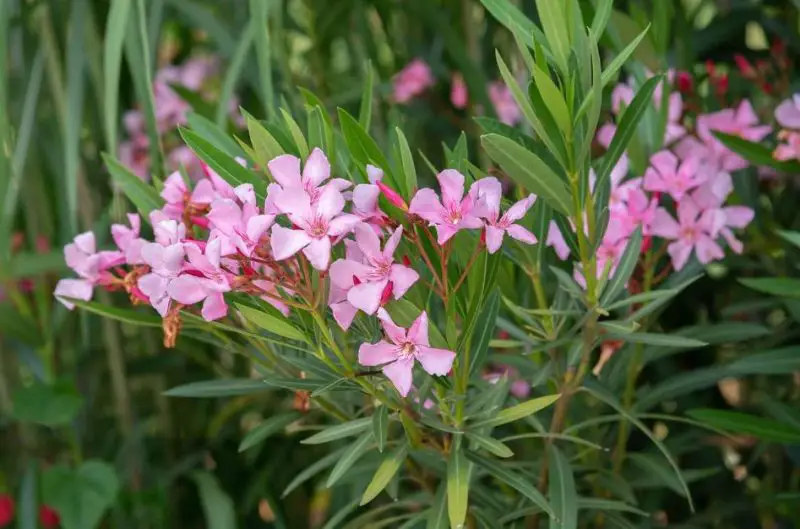
Rose Laurel (Nerium oleander) is a versatile evergreen tree celebrated for its summer blooms of fragrant purple, white, or pink trumpet-shaped flowers. Its glossy green foliage consists of long, narrow leaves, and it thrives in drought-tolerant conditions with well-drained soil. Ideal for hedges, privacy screens, or as a specimen plant, rose laurel grows up to 13 ft. tall and wide.
It flourishes in USDA Hardiness Zones 8 to 10, requiring full sun to partial shade. Caution is advised due to its toxicity to humans and pets.
Japanese Snowbell ‘Pink Chimes’
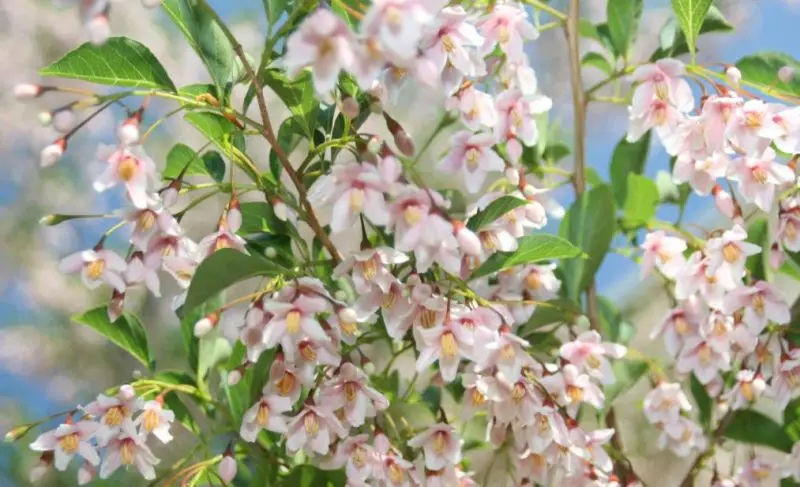
Japanese Snowbell ‘Pink Chimes’ (Styrax japonicus ‘Pink Chimes’) is a deciduous ornamental tree prized for its exquisite pinkish-white flowers. This cultivar features delicate bell-shaped blooms that dangle gracefully from weeping branches during summer. Its oblong, glossy dark green leaves transition to vibrant yellow or red hues in autumn.
Ideal for acidic, humus-rich, well-drained soils with moderate moisture, ‘Pink Chimes’ thrives as a container plant or as a focal point in lawns or gardens. At maturity, it reaches 15 to 20 ft. tall and wide, flourishing in USDA Hardiness Zones 5 to 8 under partial shade.
Pink Chitalpa

Pink Chitalpa (Chitalpa tashkentensis ‘Pink Dawn’) is a fast-growing deciduous tree prized for its striking clusters of pink to white trumpet-shaped flowers resembling orchids. Blooming from summer through fall, these flowers attract butterflies and hummingbirds. The tree features glossy green leaves that turn yellow in autumn before dropping, exposing its attractive grayish-white bark.
Ideal for small backyards, Pink Chitalpa thrives in USDA Hardiness Zones 6 to 11, performing best in full sun to partial shade. It provides excellent shade near patios and is a standout summer flowering tree.
Pink Powderpuff Tree
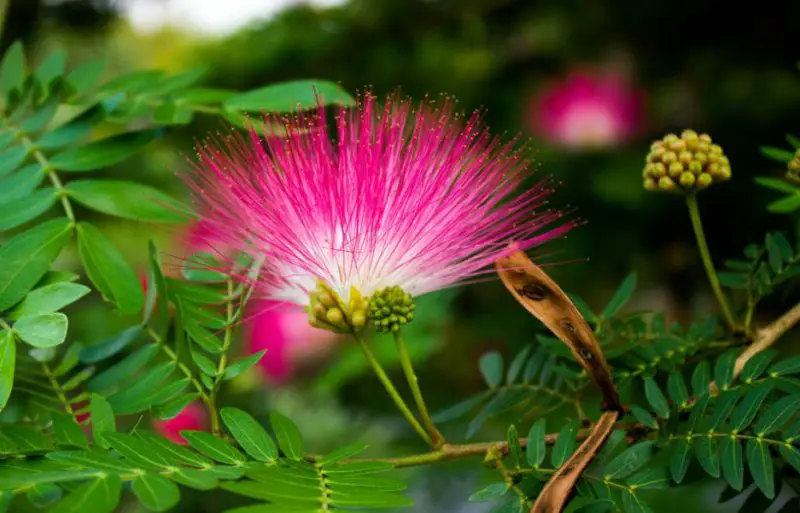
The Pink Powderpuff Tree (Calliandra haematocephala) is a tropical marvel, featuring masses of vibrant dark pink puffball-like flowers. These fluffy, pink to red flowers are adorned with numerous stamens, creating a fuzzy appearance. The tree’s small, feathery leaves enhance its delicate and graceful profile.
Native to Florida, pink powderpuff trees thrive as ornamentals in gardens, adding a spectacular burst of color and beauty to summer landscapes. They grow to 10 to 15 ft. tall and wide, flourishing in USDA Hardiness Zones 9 to 11 under full sun.
Pink flowering Rose of Sharon
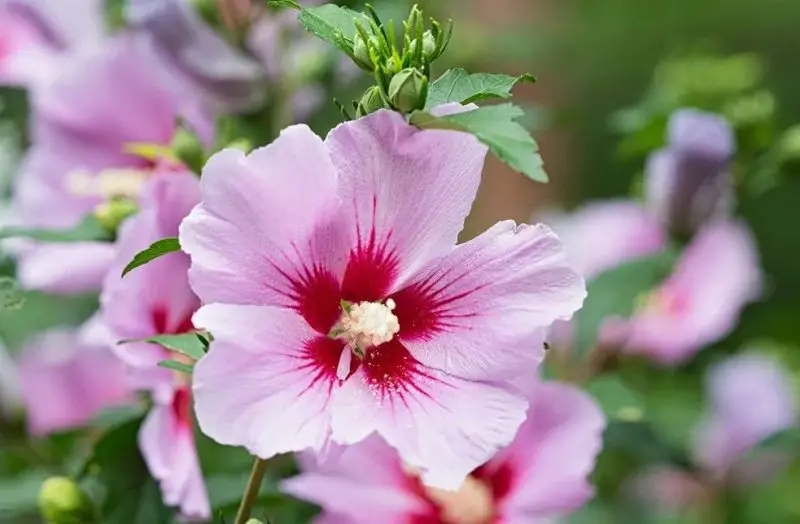
The Pink Flowering Rose of Sharon (Hibiscus syriacus) is a hardy shrub known for its vibrant pink, lavender, or magenta flowers that adorn gardens throughout summer. Available in single or double blooms depending on the cultivar, this multi-stemmed shrub-like tree can also be trained to grow with a single trunk.
It thrives in well-draining soil kept consistently moist and benefits from regular watering during summer months. Ideally planted in full sun, it reaches heights of 8-12 ft. and spreads 6-10 ft. wide, thriving in USDA Hardiness Zones 5 to 8.
Black Lily Magnolia
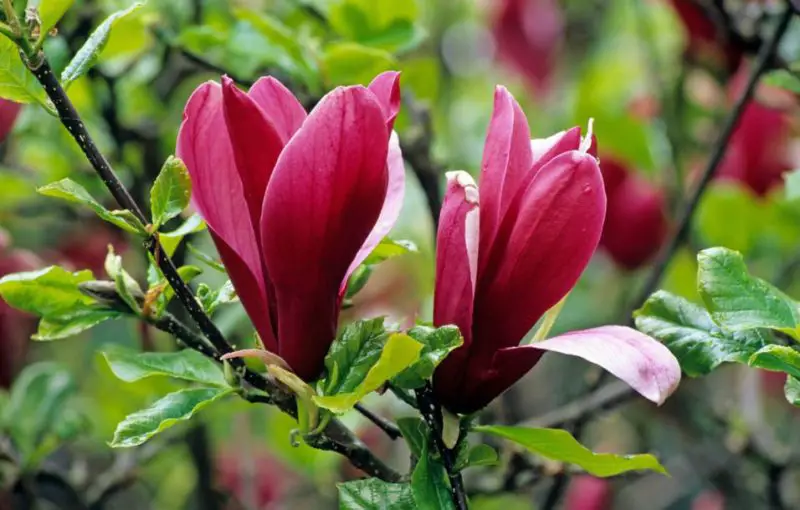
The Black Lily Magnolia (Magnolia liliiflora ‘Nigra’) is a small tree known for its large, dark pink to purple, lily-like flowers. These highly fragrant blooms appear in late spring and sporadically through summer, measuring 5” (12 cm) long. The tree’s glossy, dark green leaves complement the vibrant flowers.
Growing 8 to 12 ft. tall and wide, it’s ideal for compact gardens and prefers well-drained, slightly acidic soils. It thrives in USDA Hardiness Zones 5 to 9 and prefers full sun to partial sun.
Pink Peacock Flower
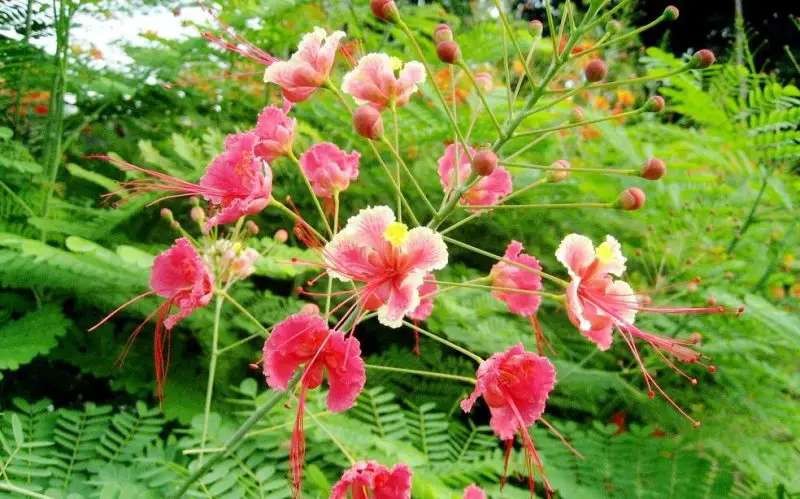
The Pink Peacock Flower (Caesalpinia pulcherrima ‘Rosea’) is a stunning small ornamental tree adorned with clusters of pink-reddish flowers. These blossoms feature long, thin stamens emerging from bowl-shaped petals, creating an exotic appearance. Its fern-like foliage contrasts beautifully with brown seed pods.
Ideal for smaller gardens or as an accent tree in larger yards, it grows 10 to 15 ft. tall and 6 to 12 ft. wide. Thriving in USDA Hardiness Zones 9 to 11, it prefers full sun and is prized for its vibrant floral display.
Kanzan Cherry Tree
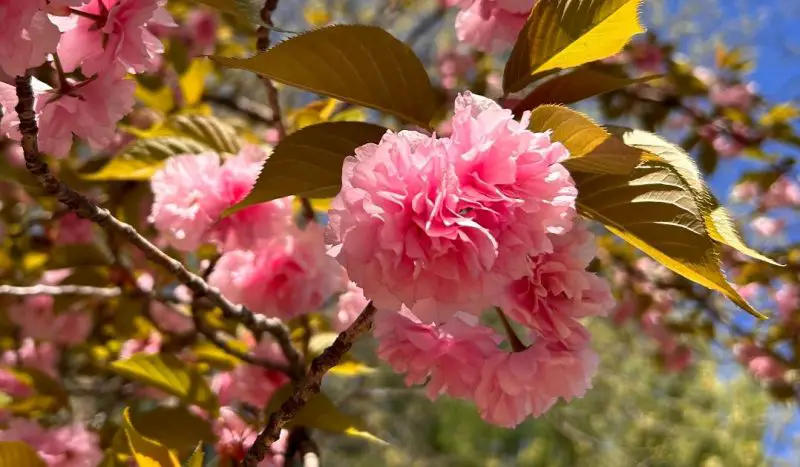
The Kanzan cherry tree (Prunus serrulata ‘Kanzan’) is celebrated for its spectacular display of double pink flowers, which bloom in dense clusters during spring. Its dark green leaves, with serrated edges, transition to orange or bronze in autumn, enhancing its seasonal appeal.
These trees are adaptable to various soils and are low-maintenance, making them ideal as ornamental shade trees in landscapes. They range from 3 to 30 ft. tall and 25 ft. wide, thriving in USDA Hardiness Zones 5 to 9 under full sun.
Higan Cherry Tree
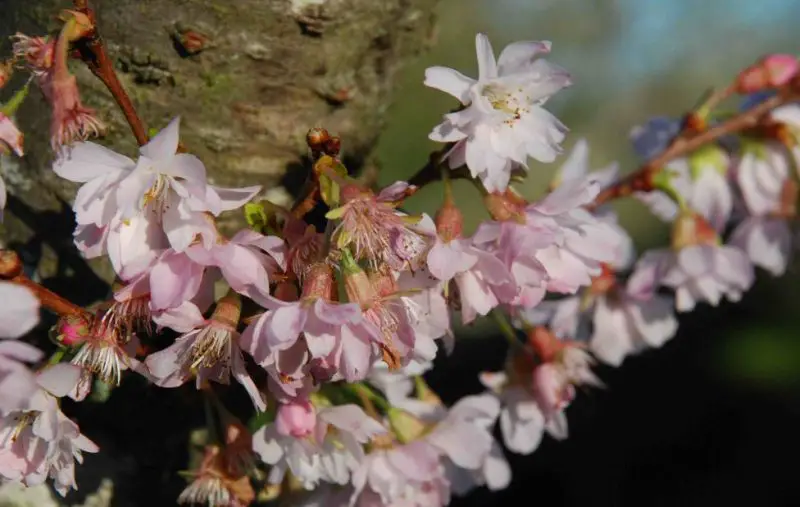
The Higan cherry tree (Prunus × subhirtella) is renowned for its stunning display of pinkish-white, fragrant flowers. These cup-shaped blooms, with 10 petals each, cluster beautifully in spring, contrasting with its sharply toothed, deep green leaves and later yielding small black fruits.
With foliage that turns yellow or reddish-orange, this tree thrives in various well-drained soils and is ideal as a lawn specimen or focal point in gardens. It reaches 20 to 30 ft. tall and 15 to 30 ft. wide, flourishing in USDA Hardiness Zones 6 to 8 under full sun to partial shade.
Weeping Cherry Trees
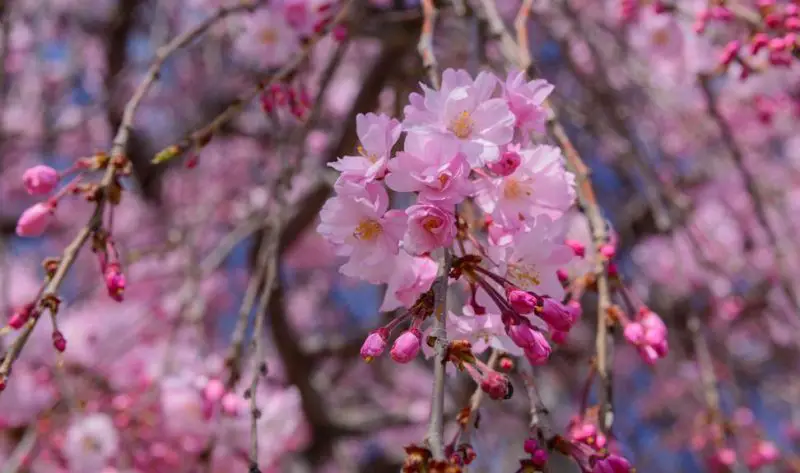
Weeping cherry trees (Prunus pendula) are prized ornamentals with pale pink or pinkish-white flowers and a graceful, cascading habit. Their glossy green leaves turn vibrant shades of yellow, orange, or bronze in autumn, accompanied by small black fruits.
Bursting into breathtaking displays of cascading blooms each spring, these trees create stunning focal points in gardens, with their pleasant fragrance adding to their allure. They thrive in full sun and reach a mature size of 15 to 25 ft. tall and wide, suitable for USDA Hardiness Zones 6 to 8.
Pink Trumpet Tree
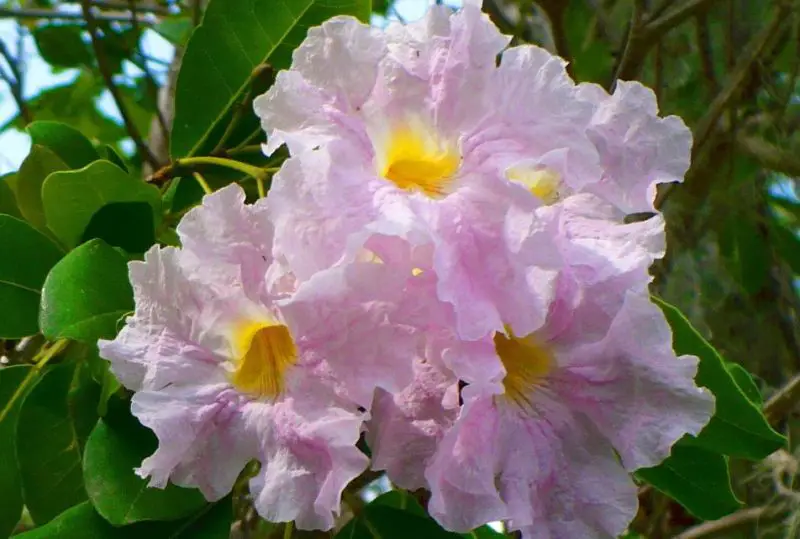
The Pink Trumpet Tree (Tabebuia heterophylla) is renowned for its abundance of vibrant pink trumpet-shaped flowers that adorn its rounded canopy in late winter or early spring, transforming it into a breathtaking spectacle of pink. These flowers not only beautify gardens but also attract pollinators like bees and butterflies.
Against its dark green glossy foliage, the contrast is striking. Ideal for adding shade to decks or patios, these trees grow to 20-30 ft. tall and 15-25 ft. wide in USDA Hardiness Zones 10 to 11, thriving in full sun.
Cherry Blossom Tree ‘Pink Perfection’
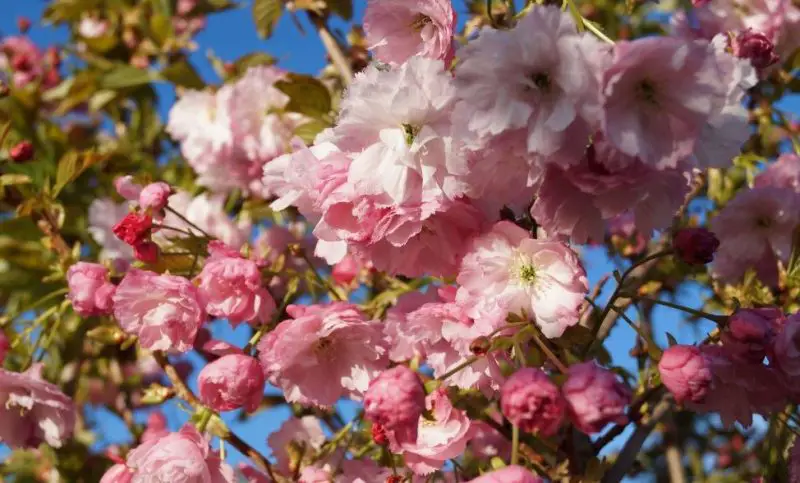
‘Pink Perfection’ cherry blossom (Prunus serrulata ‘Pink Perfection’) is a stunning small ornamental tree adorned with abundant clusters of fragrant, double-pink flowers in late spring. Each blossom features approximately 30 ruffled petals, creating a lush display. Its twisted branches support leaves that turn vibrant red and orange in autumn, adding to its seasonal charm.
Ideal for smaller landscapes, these trees thrive in full sun and reach 10 to 15 ft. tall and up to 12 ft. wide, making them suitable for USDA Hardiness Zones 6 to 8.
Yoshino Cherry Tree ‘Awanui’
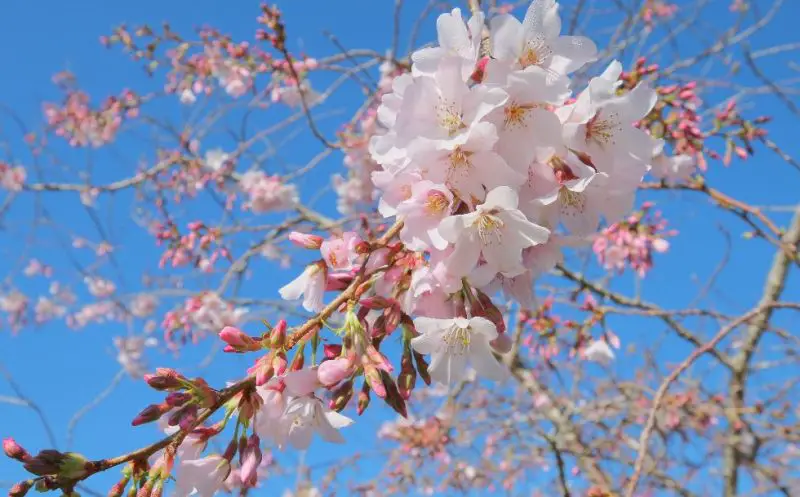
The Yoshino Cherry Tree ‘Awanui’ (Prunus x yedoensis ‘Awanui’) is a medium-sized, pink-flowering tree admired for its profusion of fragrant, pale pink flowers in spring. These almond-scented single blooms form clusters, creating a stunning floral display that attracts birds and pollinators over two to three weeks. After flowering, vibrant green leaves emerge alongside shiny black drupes.
Low-maintenance and adaptable to various soils, this tree provides summer shade and is ideal as a specimen or lawn tree in USDA Hardiness Zones 5 to 8, thriving in full sun.
Pink-Flowering Crabapple Trees

Pink-flowering crabapple trees are beloved for their stunning spring blooms in various shades of pink, from soft hues to deeper tones. These trees, adorned with single, semi-double, or double flowers, create a fragrant and visually striking display in gardens. After flowering, they develop dark green foliage and small, cherry-like fruits on their twisted branches.
Ideal for ornamental planting or as informal hedges, popular varieties include the showy ‘Robinson’ with its pink blossoms, the narrow and columnar ‘Pink Spires’, and the ‘Brandywine’ known for its double pink blooms and vibrant foliage.
Red Horse Chestnut

The Red Horse Chestnut (Aesculus x carnea) is a striking shade tree celebrated for its bright clusters of rose-red and pink flowers blooming in late spring. These vibrant blooms grow upright in conical clusters against the tree’s dark green foliage. Medium-sized, it thrives in various landscapes as a shade or specimen tree in larger yards or parks.
Recognizable for its spiny capsules containing shiny brown nuts, it reaches 30 to 40 ft. tall and wide, thriving in USDA Hardiness Zones 5 to 8 under full sun or partial shade.
Orchid Tree
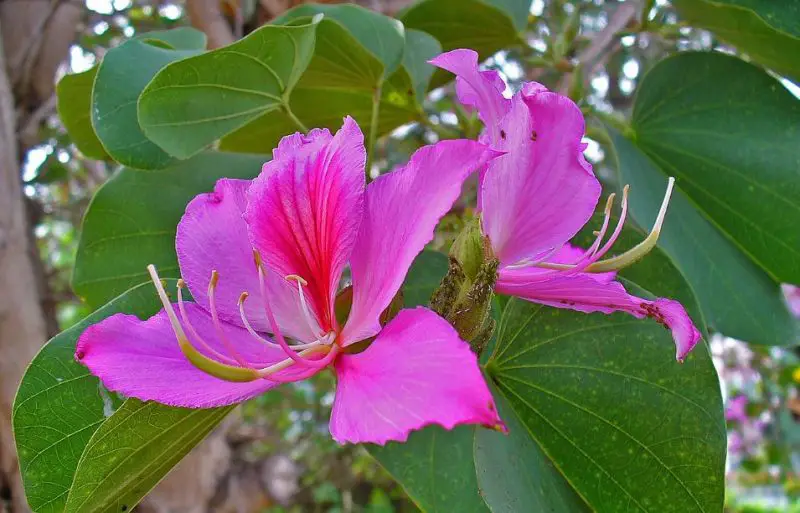
Hong Kong Orchid Tree
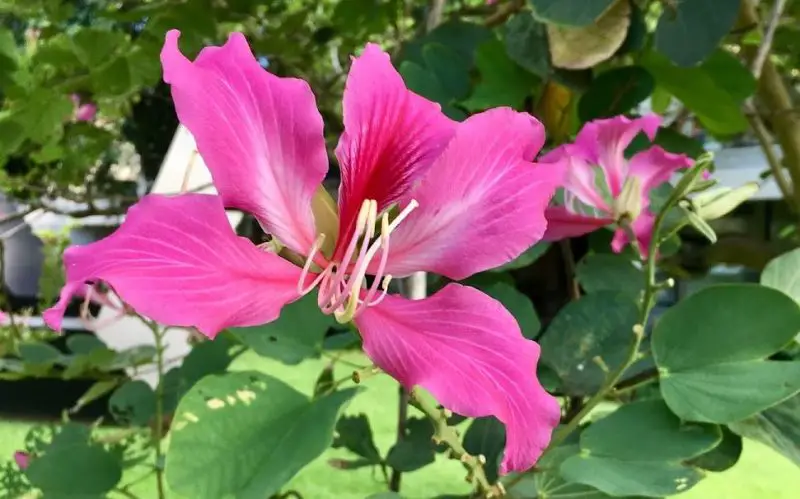
The Hong Kong Orchid Tree (Bauhinia × blakeana) is renowned for its stunning, orchid-like flowers that bloom profusely from fall through spring. These large, fragrant flowers display vibrant shades of pink or purple with arching creamy-white stamens, covering the tree in clusters that create a breathtaking spectacle.
Thriving in warm, sunny landscapes, it features an umbrella-shaped canopy of gray-green, heart-shaped leaves. Considered among the world’s most attractive flowers, it makes an ideal focal point in gardens. It matures to a size of 12 to 20 ft. tall and wide, thriving in USDA Hardiness Zones 9 to 11 under full sun.
Desert Willow
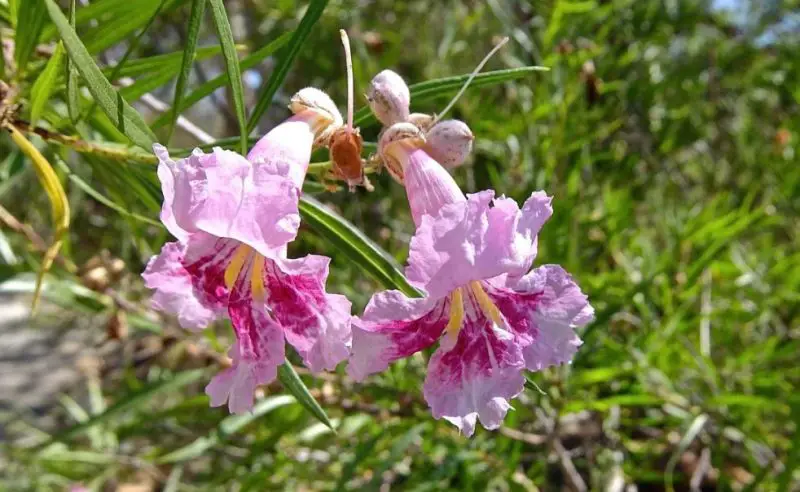
The Desert Willow (Chilopsis linearis) is prized for its stunning pink trumpet-shaped flowers with dark pink and purple streaks, emitting a sweet fragrance. Blooming in clusters from late spring through fall, its long, narrow leaves contribute to its graceful appearance.
Fast-growing and drought-tolerant, it thrives in hot, dry climates like xeriscapes and desert gardens, attracting hummingbirds and butterflies. Ideal as a lawn tree or specimen plant, it reaches 15 to 30 ft. tall and wide and is suited for USDA Hardiness Zones 7 to 11 in full sun.
Pink Trumpet Tree
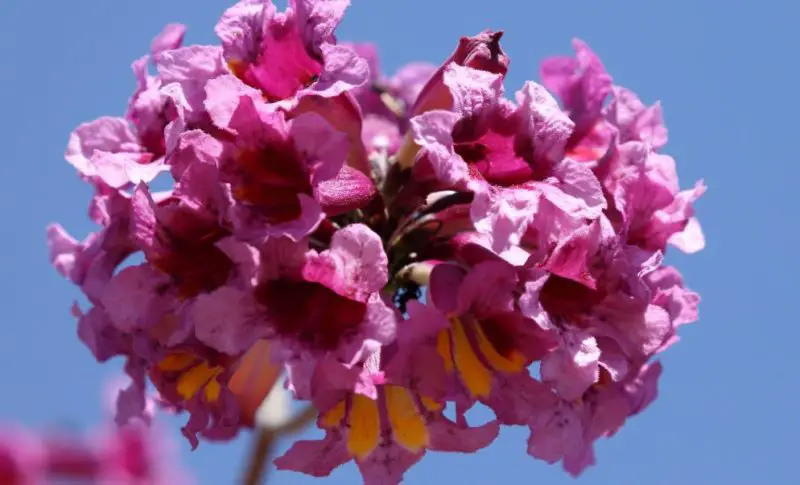
The Pink Trumpet Tree (Handroanthus heptaphyllus) graces landscapes with vibrant pink trumpet-shaped flowers. Blooming in clusters from pale to deep pink, these tubular flowers adorn the tree in spring for several weeks, creating a stunning pink canopy. Its dark green, palmate compound leaves feature serrated margins.
Native to tropical and subtropical South America, these trees thrive in well-drained clay, loam, and sandy soils, adding a burst of pink to large garden landscapes. It reaches a mature size of 40 to 50 ft. tall and 35 to 50 ft. wide, thriving in USDA Hardiness Zones 10 and 11 under full sun or partial shade.
Rosy Trumpet Tree
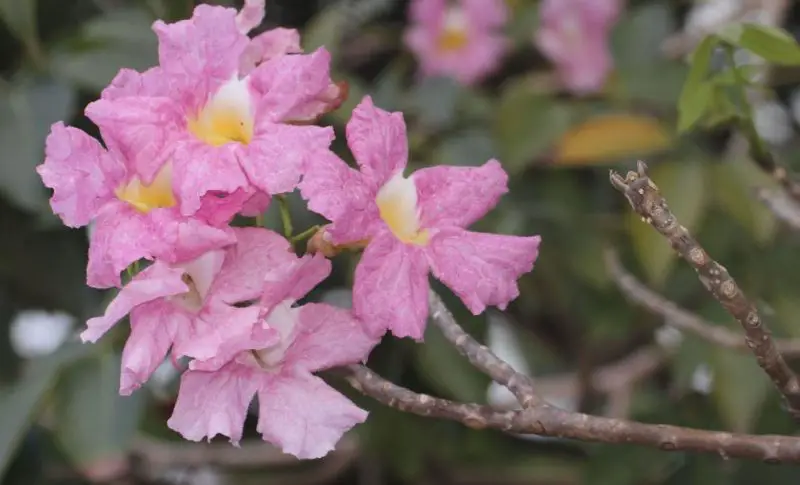
The Rosy Trumpet Tree (Tabebuia rosea) boasts lavender-pink tubular flowers with yellow throats and glossy green compound leaves. This deciduous tree thrives in deep, fertile soil, is low-maintenance, and is drought-tolerant once established.
It’s perfect for large tropical gardens, providing vibrant color from spring through summer. It matures to 60-90 ft. tall and 30-50 ft. wide, suitable for USDA Hardiness Zones 9-11 in full sun.
Royal Empress Tree
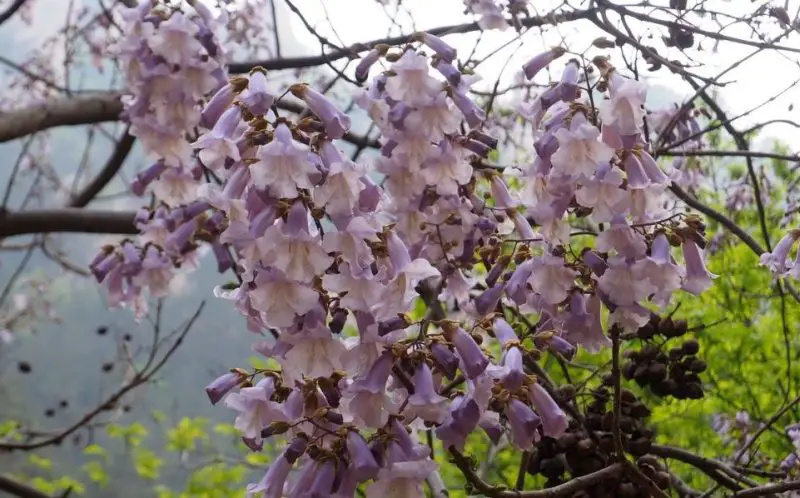
The Royal Empress Tree (Paulownia tomentosa) is renowned for its clusters of fragrant, pale pink to lavender bell-shaped flowers. This fast-growing deciduous tree features large, heart-shaped leaves with five lobes. Adaptable to various soil types and tolerant of drought once established, it is ideal as a shade or ornamental tree in larger landscapes and parks. Growing 30 to 80 ft. tall, it thrives in USDA Hardiness Zones 5 to 9, benefiting from full sun or dappled shade conditions.
Chinese Plum Tree
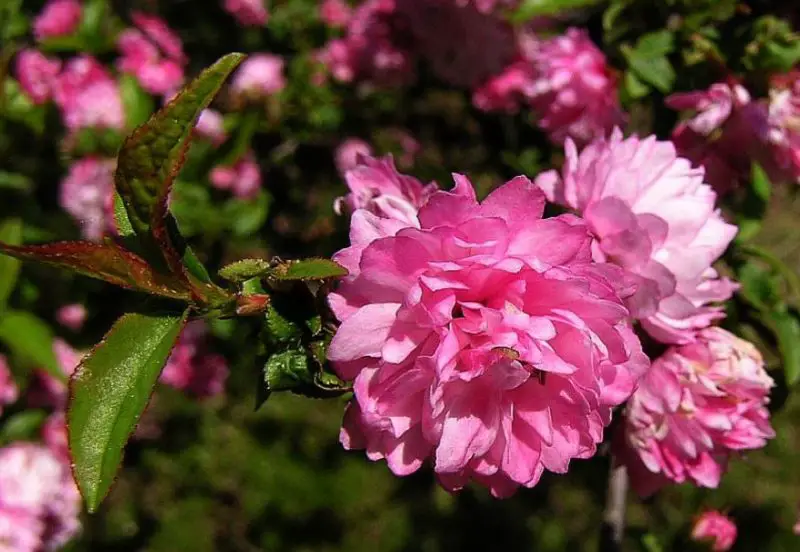
The Chinese Plum Tree (Prunus glandulosa), also known as flowering almond, is a charming dwarf ornamental shrub or small tree cherished for its clusters of pinkish-white flowers. Blooming in early spring, these cherry-like double flowers create a stunning display before the oval green leaves emerge. In autumn, the foliage transitions to a yellow hue.
Easy to cultivate, Chinese plum trees thrive in various soils with good drainage, making them ideal for ornamental use in both front and backyard landscapes. They reach a mature size of 4 to 5 ft. tall and wide, flourishing in USDA Hardiness Zones 4 to 8 under full sun to partial shade.
Purple Leaf Plum ‘Nigra’
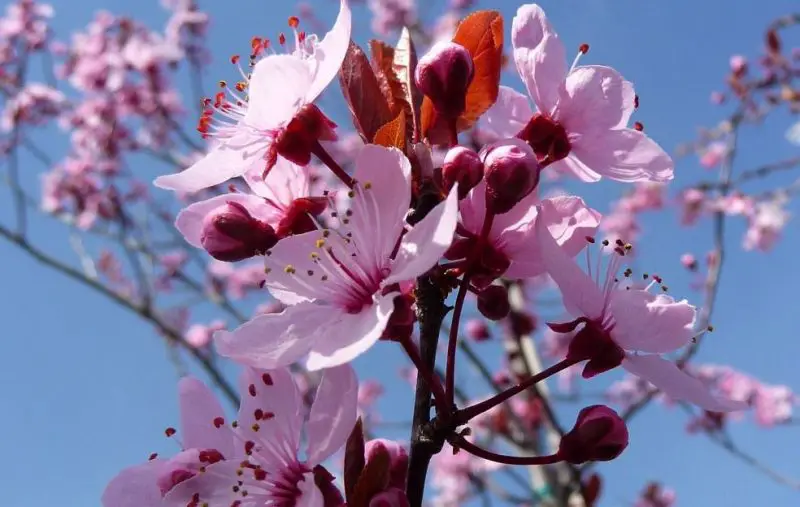
The Purple Leaf Plum ‘Nigra’ (Prunus cerasifera ‘Nigra’) stands out in gardens with its vibrant pink flowers and deep purple leaves. This ornamental tree is distinguished by its dark foliage, which is among the deepest of all plum varieties.
Thriving in moderately fertile, well-draining soils, it adapts well to small gardens, serving as a specimen plant, flowering hedge, or privacy screen. Growing 15 to 20 ft. tall and wide, it flourishes in USDA Hardiness Zones 4 to 9, revealing its darkest foliage colors under full sun.
Silk Tree
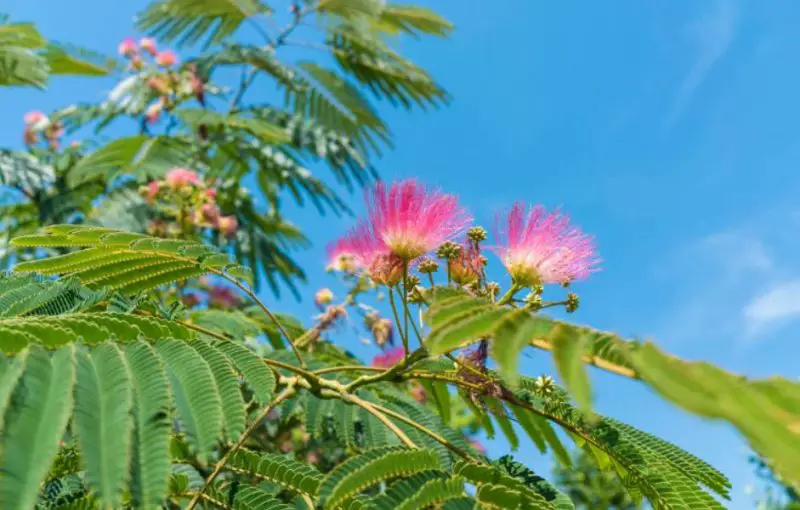
The Silk Tree (Albizia julibrissin), commonly known as the mimosa tree, captivates with its distinctive pink, fluffy powderpuff flowers. Blooming abundantly in early summer, these flowers feature long delicate stamens, creating a fluffy appearance across the tree. Its fern-like leaves fold gracefully at night or with a gentle touch.
Silk trees are resilient, thriving in drought, heat, and coastal conditions, making them ideal for semi-tropical landscapes or coastal gardens. They reach 20 to 40 ft. in height and width, flourishing in USDA Hardiness Zones 6 to 9 under full sun.
Common Smoke tree
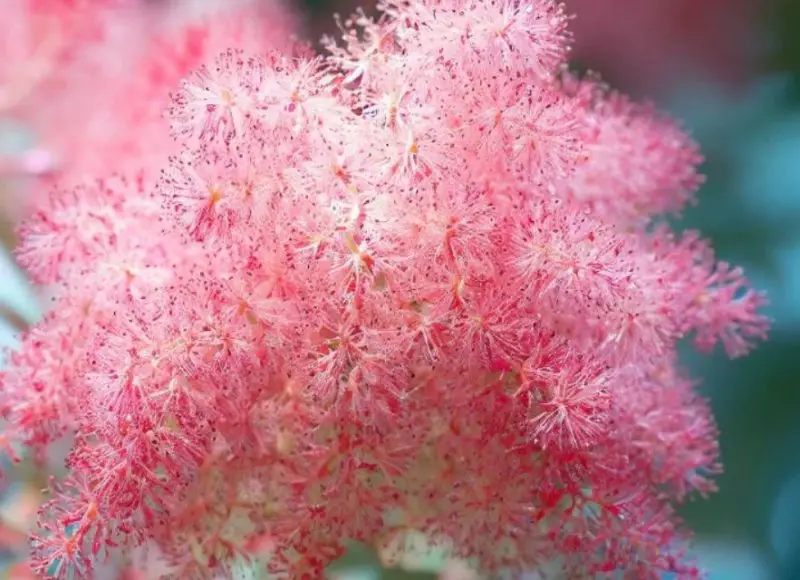
The Common Smoke Tree (Cotinus coggygria) is a deciduous ornamental known for its striking clusters of purple-pink flowers that bloom in summer. These unique flowers feature wispy filaments, giving them a smoky, airy appearance. In autumn, the tree’s foliage turns a rich reddish-purple, adding to its seasonal allure.
Cold-hardy and adaptable across USDA zones 4 to 8, smoke trees thrive in full sun to partial shade, making them versatile choices for hedges, screens, or as standalone specimens. They typically reach 10 to 15 ft. in both height and width at maturity.
Pink-Flowering Frangipani Trees
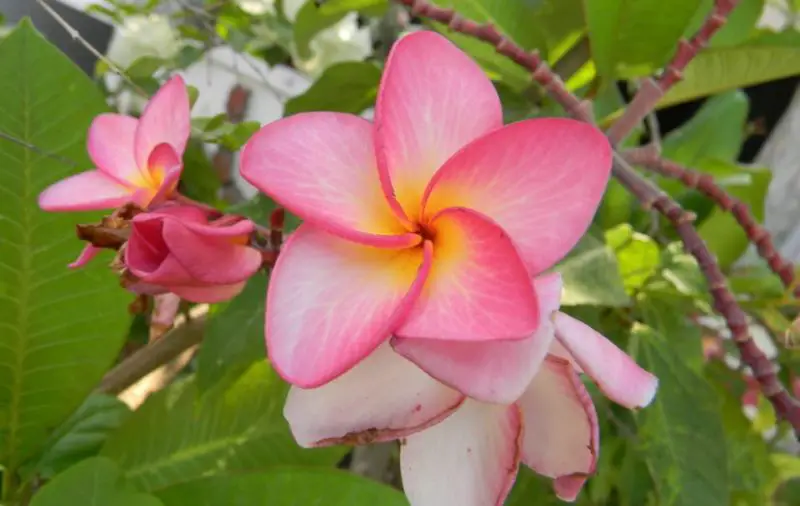
Pink-flowering frangipani trees (Plumeria) are beloved for their tropical charm, featuring star-shaped, fragrant flowers with overlapping petals. These small trees thrive in tropical climates, preferring full sun to showcase their vibrant blooms.
Varieties like Plumeria rubra boast dark pink flowers, while ‘Pink Pansy’ offers pale pink blooms with a darker margin. ‘Pink Lace’ features soft pink star-shaped flowers, and ‘Pink Lemonade’ displays thick, waxy petals in various pink shades. Pink Delight’ blooms in pink with a yellow center, emitting a sweet fragrance, while ‘Amorous Cloud’ dazzles with large, pastel pink flowers. At maturity, they typically reach 15 to 25 ft. tall and wide, thriving in USDA Hardiness Zones 10 to 12.
Pink-Flowering Fringe Trees

The Pink-Flowering Fringe Tree (Loropetalum chinense var. rubrum ‘Sizzling Pink’) dazzles with its slender, wiry deep pink petals that bloom in late spring, emitting a sweet fragrance. This dwarf shrub-like tree features dark purplish leaves, enhancing its dramatic appeal.
Ideal for foundation planting, small groups, or containers, it thrives in well-drained soils under full sun to partial shade. At maturity, it reaches 6 to 8 ft. tall and wide, flourishing in USDA Hardiness Zones 7 to 9.
Floss Silk Tree
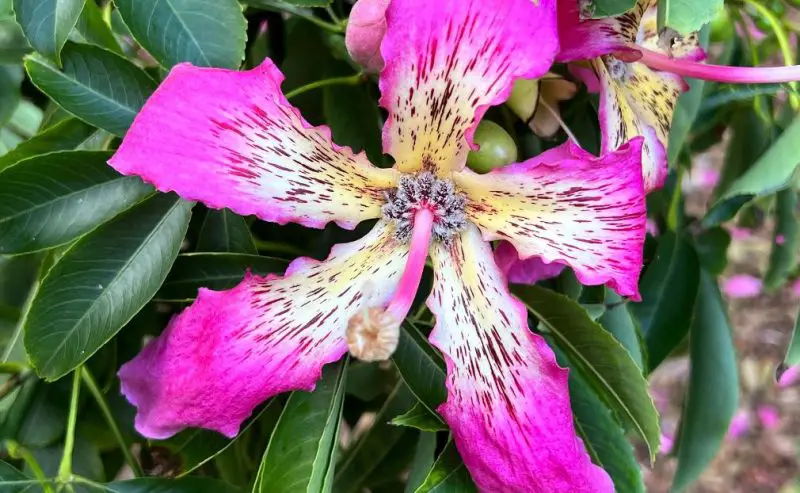
The Floss Silk Tree (Ceiba speciosa) charms year-round with its striking pink hibiscus-like flowers, each boasting five magenta-pink petals with wavy margins and a prominent stamen. This tree features dark green palmate leaves that turn yellow in autumn, complementing its pear-shaped fruits filled with silky floss-covered seeds.
Known for its spiny trunk and smooth, grayish-brown bark, the floss silk tree reaches 35 to 50 ft. tall and 40 to 55 ft. wide. It thrives in USDA Hardiness Zones 9 to 11 under full sun, requiring careful consideration due to its spiky trunk.
Pink Shower Tree
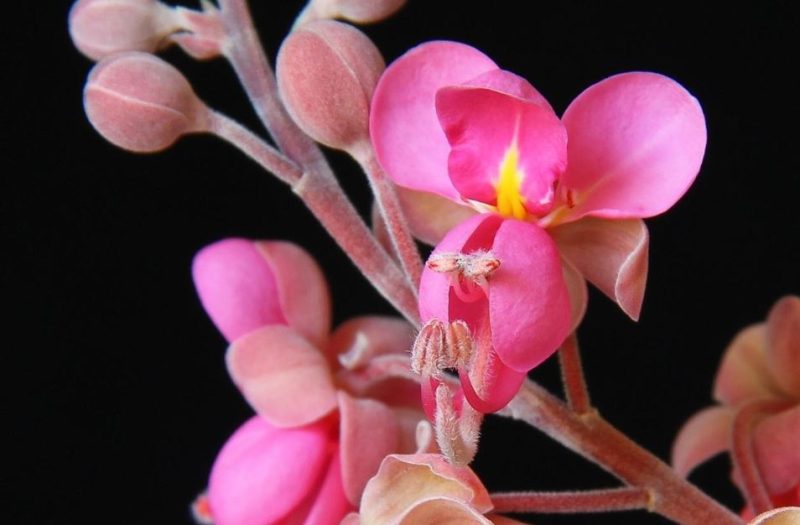
The Pink Shower Tree (Cassia grandis) is a tropical deciduous tree renowned for its clusters of stunning pink flowers, complemented by attractive pinnate leaves and long bean-like seed pods. Its lush foliage provides ample shade, while the pinkish-white flowers lend an exotic touch to any landscape.
Growing 40 to 60 ft. tall and wide, it thrives in USDA Hardiness Zones 10 to 12, preferring full sun to partial sun conditions for optimal growth and flowering.
The Eastern Redbud
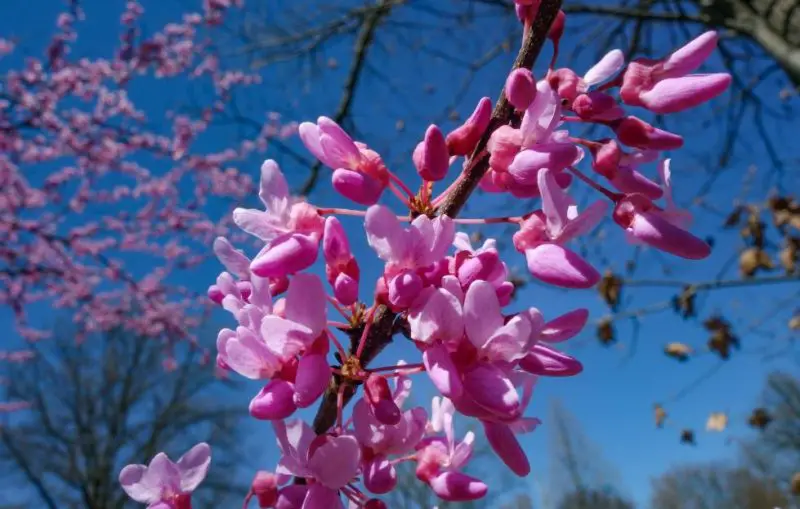
Bright pink or purple blooms that blossom in early spring are the hallmark of the small deciduous Eastern Redbud tree (Cercis canadensis). It offers seasonal beauty to gardens with its heart-shaped leaves that turn yellow in the fall.
With a height range of 20 to 30 feet, this versatile tree grows well in a variety of soil conditions. In USDA Hardiness Zones 4 through 9, it draws pollinators, improves ecological value, and grows well.
The Western Redbud

The gorgeous pink flowers and heart-shaped leaves of the deciduous Western Redbud (Cercis occidentalis) tree are striking. Its flowers appear before the leaves in the early spring. Fall foliage changes to rusty crimson to golden yellow. After flowering, the tree produces long, purple-brown seed pods that have an appealing winter silhouette due to their compact, irregular branching behavior.
A mature person is between ten and fifteen feet tall and wide. It can grow in a variety of soil types and does well in USDA Hardiness Zones 6 through 9.
Crape Myrtle
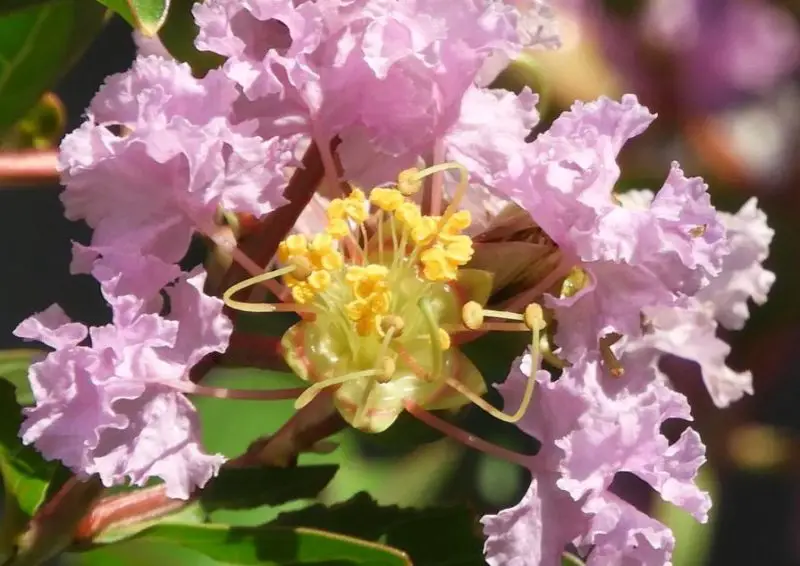
The fragrant, brilliant pink flowers in a variety of colors are clustered together by the Crape Myrtle (Lagerstroemia indica), which blooms for several weeks during the summer. In the fall, its oblong, dark green leaves turn purple, crimson, and orange. It is perfect for landscapes where it can be used as a hedge, screen, huge shrub, or decorative tree.
It thrives in well-drained loamy or clay soils and is low-maintenance and drought-tolerant. Crape myrtle trees grow to a mature size of 6 to 25 feet tall and up to 20 feet wide, suitable for USDA Hardiness Zones 7 to 9.
Pink Flowering Dogwood
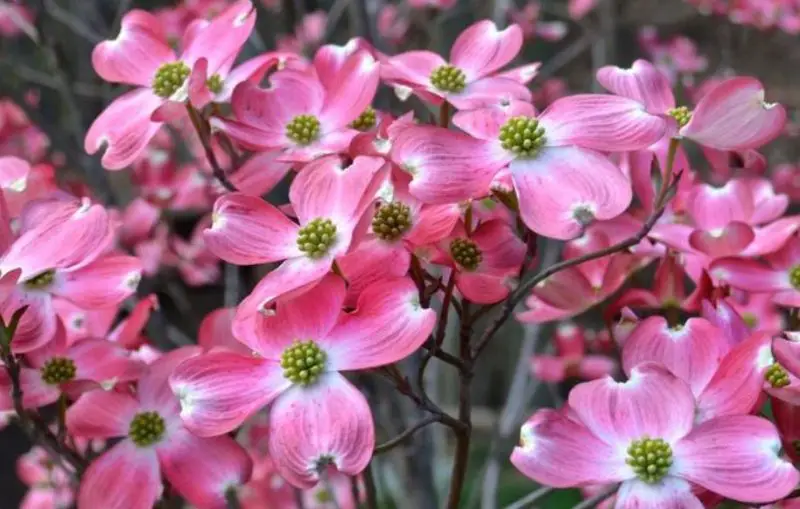
The Pink Flowering Dogwood (Cornus florida ‘Rubra’) is identifiable by its stunning pink flowers in early spring, with five bract-like petals surrounding tiny green flowers. In summer, orange-red fruits appear, and the green ovate leaves turn vibrant red in the fall.
This tree, growing 15 to 30 feet tall and wide, thrives in partial shade in USDA Hardiness Zones 5 to 9, offering year-round ornamental value.
Pink Flowering Japanese Dogwood Tree
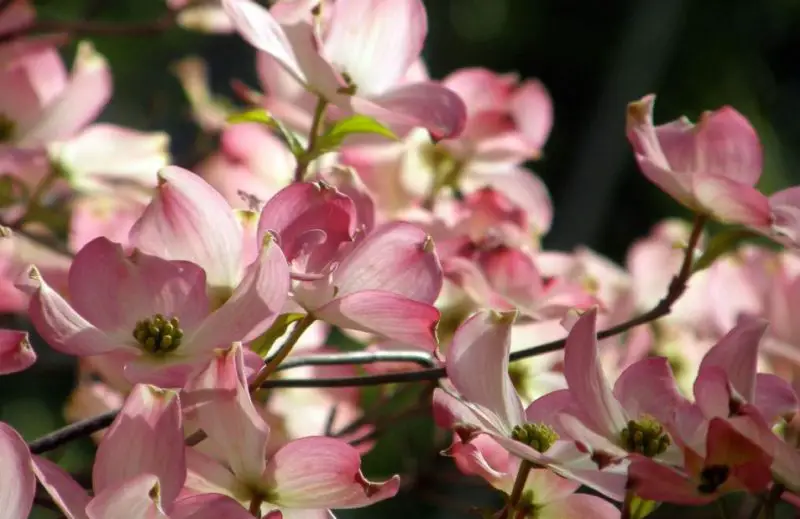
Japanese dogwood trees, such as Cornus kousa ‘Rutpink’ and ‘Miss Satomi,’ feature showy pink, star-shaped flowers on a rounded canopy. Elliptical leaves accompany the flowers, followed by small, pinkish-red fruits that attract birds. ‘Rutpink’ grows 20-25 ft. tall, has reddish-purple fall foliage, and exfoliating bark. ‘Miss Satomi’ reaches 12-15 ft., with four-petalled pink flowers, rosy-pink fruits, bright red fall foliage, and mottled bark. Both thrive in USDA zones 5 to 8.
Saucer Magnolia
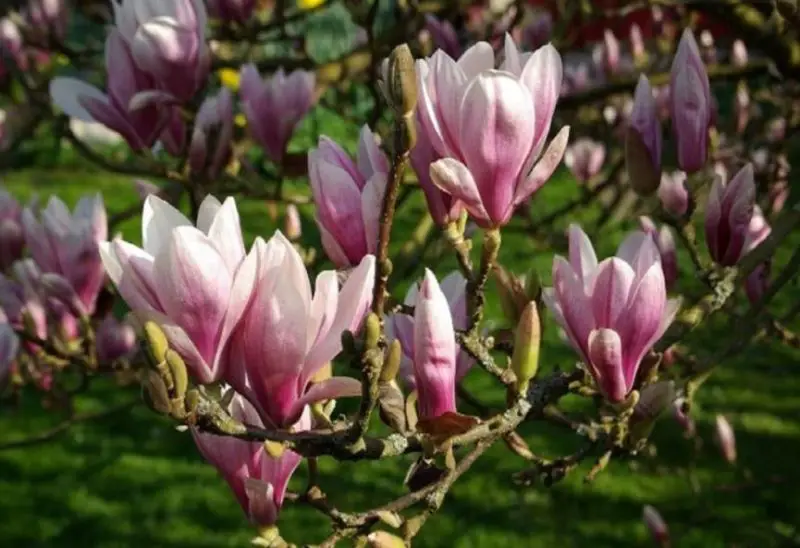
Saucer Magnolia (Magnolia x soulangeana) is a deciduous tree known for its fragrant pink, goblet-shaped flowers that bloom in spring. Also called tulip magnolia, it features large pink and white blooms and green obovate foliage that turns golden brown in fall.
This multi-stemmed tree with a rounded shape grows 15 to 20 ft. tall and wide, thriving in USDA zones 6 to 9. Ideal for ornamental gardens, it prefers well-drained soil and full sun to partial shade.






